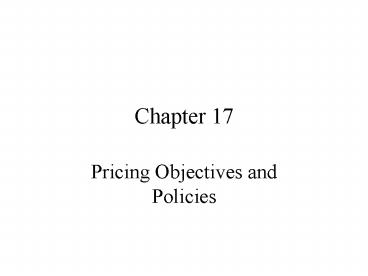Pricing Objectives and Policies - PowerPoint PPT Presentation
Title:
Pricing Objectives and Policies
Description:
Chapter 17. Pricing Objectives and Policies. Pricing Strategy Determines ... x = 106.67 or 107 units (round up since you can't sell partial units) ... – PowerPoint PPT presentation
Number of Views:55
Avg rating:3.0/5.0
Title: Pricing Objectives and Policies
1
Chapter 17
- Pricing Objectives and Policies
2
Pricing Strategy Determines
- 1 How flexible prices will be
- 2 At what level prices will be set over the
Product Life Cycle - 3 To whom and when discounts and allowances will
be given. - 4 How transportation costs will be handled
3
Review some Terms
- Profit Revenues - Costs
- Contribution Revenues - Direct Variable
- Costs
- Unit Contribution Selling Price
- Unit Variable
Costs - Variable costs increase with every unit sold or
produced - Most (but not all) marketing costs are variable
costs
4
Price Cuts Increases Have a Direct Profit Impact
- You have a contribution margin of 20, unit price
100, 80 units were sold last month. You
decide to cut your price 5. - How many units will you have to sell to have the
same contribution as last month?
5
Price Cuts Increases
- Last months unit contribution 20
- 20 unit contribution x 80 units sold
- 1,600 contribution last month
- We would like to have a contribution of 1,600 or
better this month.
6
Price Cuts Increases
- New unit contribution 20 - (100 x .05) 15
- To make same contribution as last month
- 1,600 15x
- x 106.67 or 107 units (round up since you cant
sell partial units). - Your sales must increase (107-80)/80 33.75 to
make the same contribution
7
Price Cuts Increases
- Note Increasing or cutting prices usually does
not effect the costs of a firm. - If you can make a price increase stick and demand
does not fall (much), your profitability is
sharply increased. - If you cut your price, you have to sell a LOT
MORE UNITS to make the same profit level
8
Second Example
- Unit contribution 15. Unit price 50
- Sold 300 units last year. You decide to cut
prices 10. How many units do you have to sell
to have the same contribution as last year?
9
Example 2 continued
- Old total contribution 15 x 300 4,500
- New unit contribution 15 - (50 x .10)
- 10
- Units needed to be sold to make the same
contribution as last year - 4,500 10x 450 units
- Sales increase of (450-300)/300 50
- Can you get this 50 sales increase?
10
Example 3
- Unit contribution 9, unit price 90, sold
900 units last year. You decide to raise prices
10. How many units do you have to sell to have
the same contribution as last year?
11
Example 3 cont.
- Total Contribution 9 x 900 8,100
- New unit contribution 9 10 19
- 8,100 19x 427 units
12
Pricing Objectives
- 1 Target Return (459)
- 2 Profit Maximization (460)
- 3 Sales Oriented
- Market share Firms sales in units (dollars)/
- Industry sales in units
(s) - Status Quo (460)
13
Product Life Cycle Pricing
- Skimming (464) vs Penetration (466)
- Skimming
- Recoup Costs Quickly
- Aim at members of the target that have strongest
desire - Helps with production distribution
- Penetration - discourages competitive entry
builds market share quickly
14
Quantity Discounts
- Discounts offered to encourage customers to buy
in larger amounts (469). - Can be price cuts or free goods
- Often given due to economies of scale in
production, distribution, ordering - Two types
- Cumulative Quantity Discounts (469)
- Noncumulative Quantity Discounts (469)
15
Cumulative vs Noncumulative
- Your firm sells plastic containers. Your price
structure is - Less than 1000 units - 0.65 each
- 1000 - 4999 units - 0.60 each
- 5000 - 9999 units - 0.55 each
- 10,000 units - 0.50 each
16
Cumulative vs Noncumulative 2
- Zed buys 1200 units in January, 500 units in
February and 3,800 units in March. What was the
total price paid if the discounts were - Cumulative?
- Noncumulative?
17
Cumulative vs Noncumulative
- Cumulative 1200 500 3800 5500 units.
Total price 5500 x 0.55 3,025 - Noncumulative
- 1200 x 0.60 720
- 500 x 0.65 325
- 3800 x 0.60 2,280
- Total 3,325
18
Cash Discounts
- Reduction in price to encourage buyers to pay in
cash (470). - Ex 2/10, net 30. Reads
- 2 discount if paid in 10 days of the invoice
date full amount due in 30 days. - What is the annual interest rate here?
19
Cash Discount
- Paying for 20 days use of the money
- (net 30 - 10 day discount period)
- How many annual periods? 365/20 18.25
- Annual interest rate 36.5
- You can change credit terms by altering the net
date, the discount period, or the discount
20
Distribution Pricing
- F.O.B. - Free on Board some vehicle at some
place. FOB delivered - seller pays freight and
retains title until product is delivered (474) - F.O.B. Shipper - buyer pays freight and takes
title at the shippers loading dock.
21
Distribution Pricing
- F.O.B. Delivered (474)
- Zone Pricing (474)
- Uniform Delivered Pricing (474)
22
Legal Issues
- Price Fixing (480) (mins maxes)
- Robinson Patman Act (480)
- illegal to sell to different business buyers at
different prices if it injures competition - Can have different prices if
- Based on cost differences
- Meet the actions of competitors
- Must make allowances available to all customers
on a proportionally equal basis unless there is
a cost basis for doing so.































